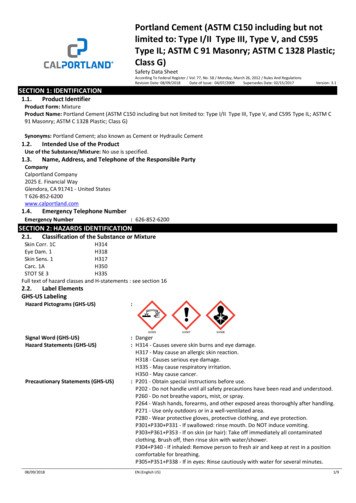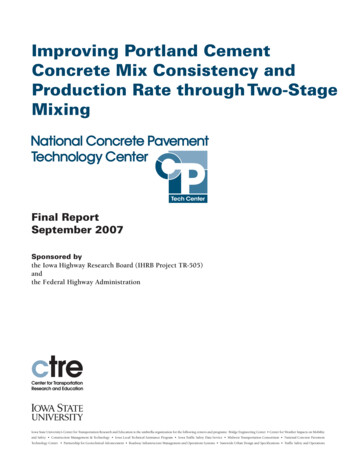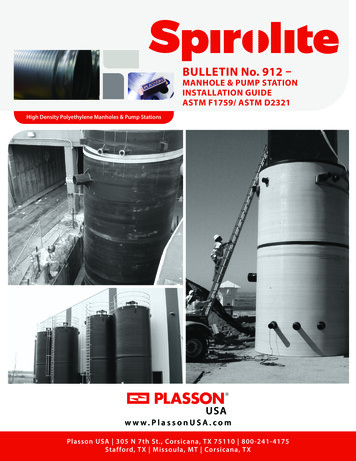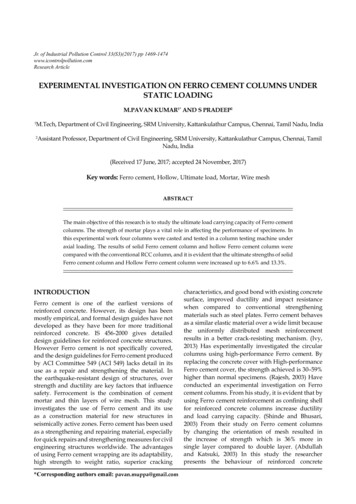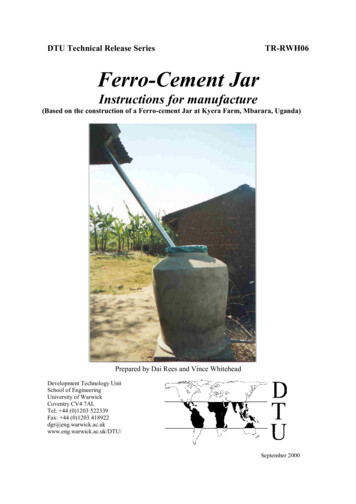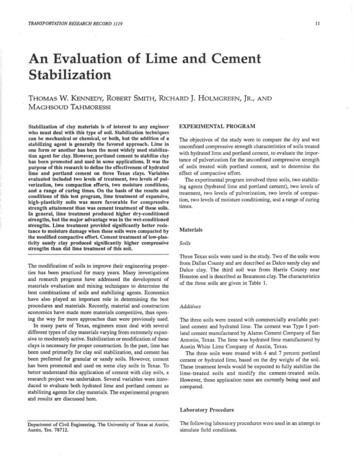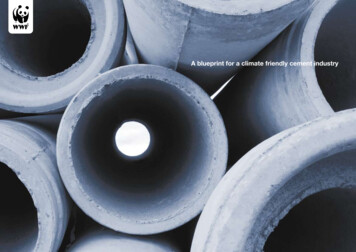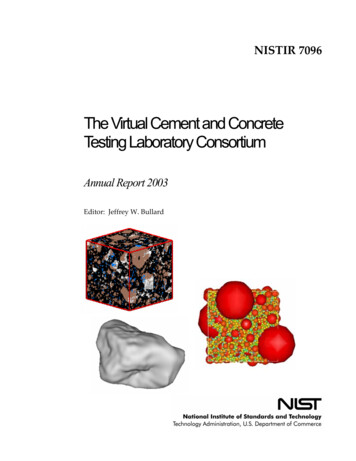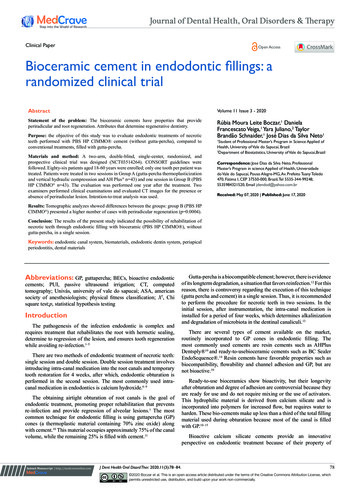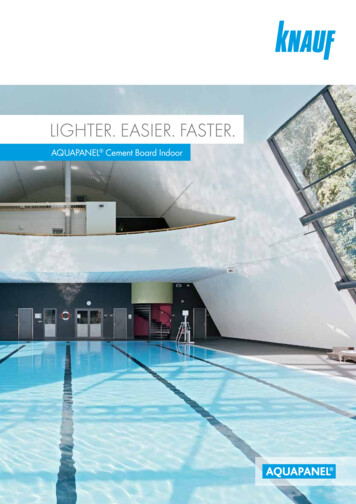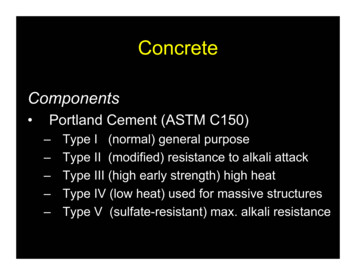
Transcription
ConcreteComponents Portland Cement (ASTM C150)–––––Type I (normal) general purposeType II (modified) resistance to alkali attackType III (high early strength) high heatType IV (low heat) used for massive structuresType V (sulfate-resistant) max. alkali resistance
ConcreteComponents Aggregates–––––– Coarse, fine, and lightweight60 to 80% volume of mixStrong and durableResistant to freezing and thawingChemically stable (ASR)Saturated surface-dry (SSD) optimum conditionWater– Potable, balanced pH, no organics or salts
ConcreteComponents Admixtures– Air-entraining agent: Greater resistanceto freezing andthawing Greater chemicalresistance Reducespermeability Improvedworkability
ConcreteComponents Admixtures– Water-reducingadmixtures– Decrease waterrequirementswithout reducingworkability
ConcreteComponents Admixtures– Retarders Slows the rate of hardening to increaseworking time– Accelerators Increase the rate of hardening– Pozzolans Used to replace some of PC with var. benefits– Plasticizers Increases workability of the mix
ConcreteWater-Reducing, Set-Controlling AdmixturesASTM C 494Type AWater-reducing admixturesType BRetarding admixturesType CAccelerating admixturesType DWater-reducing & retarding admixturesType EWater-reducing & accelerating admixtures
ConcreteMix Design Water/cement ratio directly affects:– Compressive strength High W/C ratio lower strengthLow W/C ratio higher strength– Durability– Workability or plasticity– Watertightness Slump affects:– Workability or plasticity– Shrinkage
ConcreteMix Design Cement, aggregates, and admixtures areproduced according to ASTM specsAmerican Concrete Institute (ACI) providesguidelines for mix designsSpecifications refer to and incorporate ASTMSpecs and ACI guidelines
ConcreteMix DesignConcrete specifications are generally based onone or more of the following:1. Mixture proportions designed and controlled by theowner2. Minimum cement content, max. water/cement ratio,and range of slump are specified3. Concrete strength specified @ 28 days
Paving and SurfaceTreatments Paved surfaces include:– highways and local roads– airfield runways, taxiways, and aprons– parking lots and driveways– bridges– race tracks & recreational facilities– slope paving Paved surfaces are generally rigid(PCC) or flexible (bituminous HMA)
Paving and SurfaceTreatments Surface treatmentsprovide– sealing or waterproofingexisting pavements– bond new pavement toexisting (tack coat)– wearing course for ruralroads i.e.: tar and chip
Paving and SurfaceTreatments Hotmix asphalt paving is generally placed inlayers or lifts (base, binder, and wearingcourse) Thickness of lift is in proportion to theaggregate size HMA is placed with temperatures ranging 250 - 330 F HMA must be placed on a firm, stable, welldraining base
Hotmix PavingPlacing HMA Confirm that base (GABC, recycled crushedconcrete, or gravel mix) has been compacted torequired density and is stable Existing surfaces must be swept clean Tack coat applied to existing surfaces at the ratespecified (DelDOT CSS-1-h at 0.2 gal/SY) Tack is also applied to curb, gutters, manholeframes and other surfaces where bonding isrequired
Hotmix PavingPaving Equipment Paver/Finisher spreads andprovides initial compaction ofhotmix Must be able to compensatefor minor grade irregularities,while forming crowns andsuperelevations Must be able to travel onvarious types of surfaces andpush dump trucks
Hotmix PavingPaver/Finisher Paver/Finisher consists of a tractor unitand floating screed unit Tractors are either wheel or track mounted Tractor unit includes receiving hopper,feeders, distributing augers or spreaderscrews, power plant, transmission, dualcontrols, and operators seat
Hotmix PavingPaver/Finisher The screed unit is attached to and towed by thetractor unit The screed unit is attached to the tractor by long,pivoting screed arms The screed forms and rides on the finished surface Screed unit consists of a tamping bar or vibratoryunit, thickness controls, crown controls, screedheater, and screed plate
Hotmix Paving
Hotmix PavingPaver/Finisher Operation1. Material is dumped into the hopper from atruck or conveyor unit Rollers mounted on front of paver contactrear tires of truckPaver pushes truck while it is dumping intothe hopperTruck drivers must be experienced indelivering hotmix
Hotmix PavingPaver/Finisher Operation2. Two independently controlled bar feederscarry mix through control gates to spreaderscrews Each spreading screw is synchronized to itsfeederOperator can control distribution of mix in frontof the screed unit
Hotmix PavingPaver/Finisher Operation3. Screed unit is pulled by the tractor across thematerial and adjusted to produce the desiredthickness The screed is equipped with a heater to preventthe material from sticking to the screed plateThe tamper bar or vibrating screed strikes-offand provides the initial compactionScreed units can be set for precise thickness,crown, and superelevation
Hotmix PavingPaver/Finisher Operation Paver/finishers are capable of self-leveling–– Minor base irregularities are eliminatedScreed bottom rides parallel with the direction of pullMat thickness is set by the thickness controls onthe screed––Irregularity in the base causes machine to automaticallyincrease/decrease thickness to compensateThickness changes at the screed board are not abrupt,but slowly inclining or declining until the new thicknesshas been reached
Hotmix PavingPaver/Finisher Operation Screed width can be increased or decreasedby hydraulic telescoping extensions Automatic feeder controls are movedoutward with the extensions Control of screed level can be manual,semiautomatic, or fully automatic Automatic screed controls include jointmatching shoe, string line to grade, and longski
Hotmix PavingPaver/Finisher Operation Joint-matching shoe senses surface gradeand sends information to the electroniccontrol system– Used to match adjacent pavement or guttergrade or maintain thickness over a previouscourse String line to grade system – not used often
Hotmix PavingPaver/Finisher Operation Long ski automatic grade control system– Semi-rigid boom or floating beam– Serves as a floating grade reference connectedto the electronic sensing and control system– Averages out longitudinal errors andirregularities of the surface being paved– Used generally for surface course or nearsurface binder course
Hotmix PavingPaver/Finisher Operation Pavers are alsoequipped withautomatic transverseslope control
Hotmix PavingCrew Requirements Paving crew size and composition can varydepending upon:–––––desired production rateslift thicknessamount of handworkjob conditionsUnion labor contract or agreements
Hotmix PavingCrew RequirementsBasic crew composition and function include: Foreman– Estimates and orders required material and tack– Determines labor, equipment, fuel, andmaintenance requirements– Plans actual paving operation i.e.: number oftrucks, paving sequence, direction of pulls, etc Front-line supervisor responsible for quality,production, and safety
Hotmix PavingCrew Requirements Paver Operator– Controls paver direction and speed– Controls hopper and feeders– Checks and controls overall machine operation Screedman– Controls thickness, width, and cross slope of mat– Must understand grades and machine operationand behavior
Hotmix PavingCrew Requirements Dump man– Coordinates and directs truck driver movementsand dumping– Aids truck drivers in obstructed view situations oraerial hazards– Collects material delivery tickets Shovel man– Manual distribution of material as needed
Hotmix PavingCrew Requirements Rake or “Lute” man– Rakes edges or joints to assure tight, smoothseams– Finishes areas not accessible to the paver orscreed (handwork)– Skill position that requires experience andfinesse
Hotmix PavingCrew Requirements Roller Operator(s)– Multiple operators are usually required forbreakdown, intermediate, and finish rolleroperations Lab technician– Owner’s inspector or contractor’s QA/QCtechnician (on performance spec contracts)verifying density
Hotmix Paving The paving machine is preheated prior to pavingand the grade controls are checked and set The screed board is set to a height that uponcompaction will yield the desired lift thickness Compaction is performed by steel drum watercooled rollers Roller(s) completes initial breakdown passes Intermediate rolling essentially completescompaction Finish or cold rolling removes creases and finalsealing
Hotmix Paving Rolling patterns (number of passes) is obtained bycontrol strip that determines the target density Base courses are compacted to 90% lab density Wearing courses (top) are compacted to 95%. Rolling should initiate at the curb line in thelongitudinal direction overlapping the previouspass by at least half of the roller width Alternate length of passes to avoid changingdirection at the same location Longitudinal joints or seams should be “pinched”by rolling directly behind the paving operation
Hotmix Paving Roller speed should be slow and uniform, avoidingsudden stops Idle rollers should stay only where the mat hascooled sufficiently Superpave mixes have much narrower temperatureranges for compaction “Tender zone” Various other polymer, SMA, and open-gradedmixes have special rolling requirements, and behavedifferently than conventional mixes
Hotmix Paving Minimum ambient temperature requirements:––––32 F for base courses 2”40 F for base, binder, or wearing course 2”50 F for wearing or surface courses 1”60 to 65 F for open-graded and certain polymer surfacecourses Succeeding course should not be placed until theprevious course has cooled to 140 F Traffic should not be allowed on pavement until thesurface temperature has cooled to 140 F
Hotmix Paving Tack must be applied to new pavement surfacesimmediately prior to the next lift when:– 10 days have elapsed– it has rained since placing the last lift– the surface has become dirty Tie-ins to adjoining (existing) pavements must be sawcut (transversely) to provide a clean vertical joint Tie-in smoothness is enhanced by cutting transverse“butt joints” Hotmix used to overlay concrete can be saw cut &sealed over the concrete joints to prevent reflectivecracking
Hotmix PavingPavement Rehabilitation Periodic pavement rehab can be a cost effectivemeans of extending the service life Existing surface course is removed by rotomilling(a.k.a. milling or planing) The base is patched as necessary Manhole and inlet frames are adjusted to newgrades as required New butt joints are cut Surface is cleaned, tacked, and overlaid with a newwearing course (top)
Hotmix PavingPavers working inEchelon (tandem) Elimination of coldjoint High capacity andproduction operation
Hotmix PavingMobile conveyor Material handler receivesmaterial from trucks andconveys to paver resultingin:1. Increased paverproduction2. Nonstop pavingoperation3. In-line or offset paving4. Reduced hauling costand time wasted at thepaver
Keys to Successful HotmixPaving Employ well-trained, experienced personnel i.e.foreman, operators, laborers (especially lute man!) Good grade control (survey function) Thorough understanding of the paving equipment andand electronic control systems Good mix design and production Quality control in the plant and field Desire to produce a high quality, smooth, and durablepavement
Concrete Pavement Rigid pavement placed on a stone (GABC), soilcement, or permeable treated base (asphalt or PCC) Placed using fixed forms or slipform Crew requirements depend on method of placement Modern practice is to place un-reinforced concretewith close control joint spacing @ 15’ Smooth dowel bars usually spaced 12” o.c. are usedat joints to transfer the load across the joint andprovide shear strength Bars or hook bolts are used to connect slabslongitudinally
Concrete Pavement Fixed-form placement canemployee any number ofmechanical form ridingequipment Equipment is used to spread,strike off (screed),consolidate, and finishconcrete Concrete is usually deliveredand placed by mixer trucks
Concrete Pavement Placement can be byconveying equipment Some finishing is usuallycompleted by hand– floats and trowels alongthe edges– straight edge “bumpcutters” and bull floatstransversely across theslab
Concrete PavementSlipform Paving No forms used to contain the sides of the slab Grade and alignment control is by string line followedby electronic sensors mounted on the machine Paving train operation employees single or multiplemachines for placement and distribution, forming,consolidation, and finishing State-of-the-art equipment has self-contained dowelbar and longitudinal bar inserters Concrete is usually hauled in dump trucks at a verylow slump, typically 1”
Concrete Pavement Concrete is placed directly on the grade in frontof the paving train or into a belt placer(conveying machine) Slipform strikes off and consolidates theconcrete Minimal hand finishing is generally required(bump cutter and bull float)
Concrete Pavement Automated or manualtexturing using steel tinesto form grovestransversely across thepavement Tines are 1/8” to 3/16”wide x 3/16” deep Transverse grooving bysaw cutting can beperformed after concretehas cured
Concrete Pavement Pavement is then sprayed with curingcompound to prevent rapid evaporation Saw cutting at transverse joints must be doneas soon as the concrete can be cut withoutexcessive damage to the slab i.e. spalling,tearing, rutting, or washing away mortar Saw cutting depth is typically T/4 to T/3 Upon completion of the paving and curingperiod, these joints are widened and sealed
Concrete PavementPavement Smoothness Performance spec regarding pavement smoothness D
Portland Cement (ASTM C150) – Type I (normal) general purpose – Type II (modified) resistance to alkali attack – Type III (high early strength) high heat – Type IV (low heat) used for massive structures – Type V (sulfate-resistant) max. alkali resistanceFile Size: 595KBPage Count: 73
